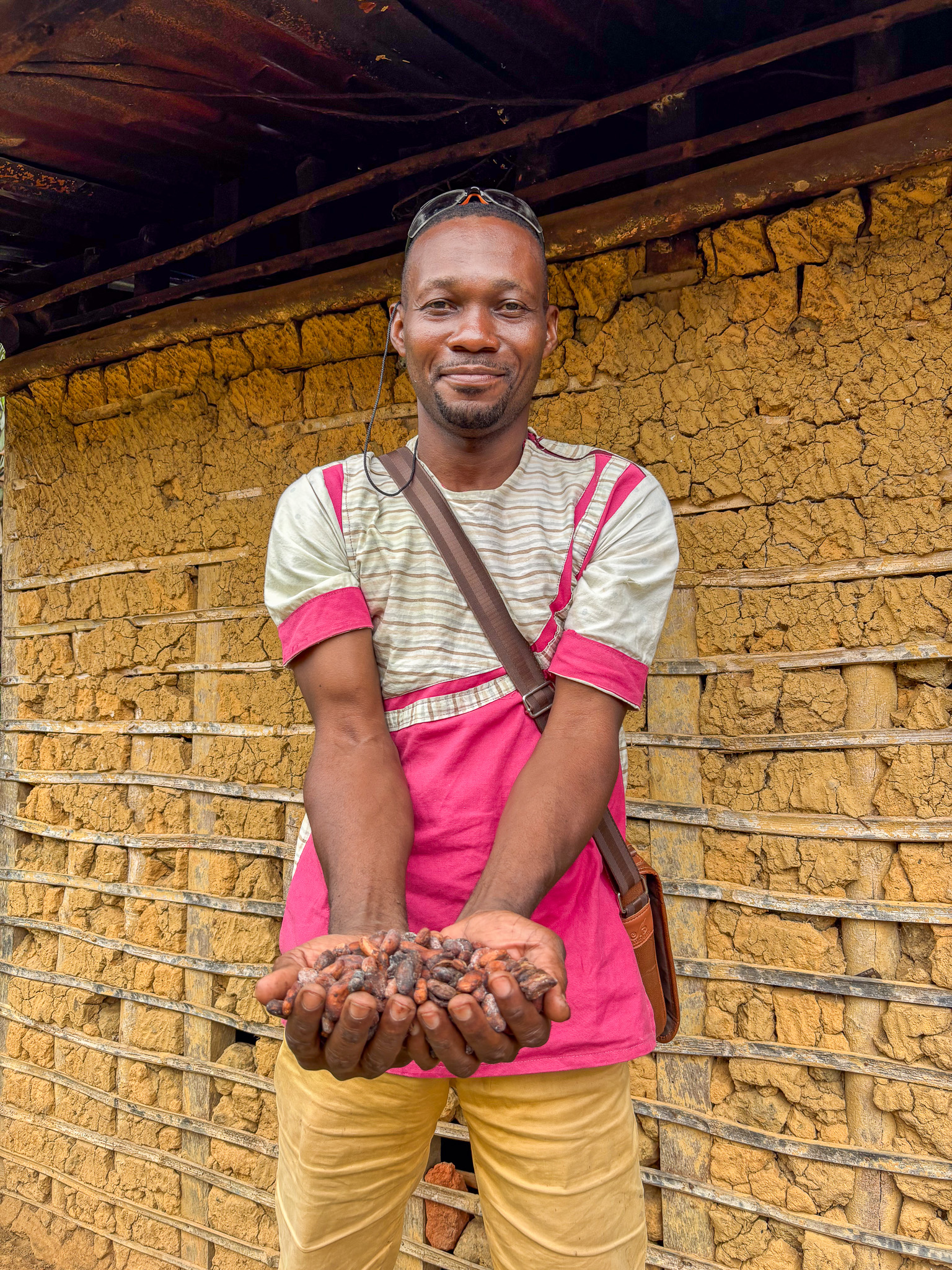From Poacher to Cocoa Farmer: Zamo Yves’ Path to Conservation in Cameroon

Zamo Yves standing in his 3.5 hectare cocoa farm in Nnemeyong in Southern Cameroon
Every morning, as the mist slowly lifts off the grass where the forest thins into farms outside Nnemeyong, Southern Cameroon, Zamo Yves walks the paths he once knew for different reasons.
He counts seedlings now, not traps.
The same trees that he used to hide from patrols now provide a canopy for his young cocoa trees. Seven children wait at home for breakfast and, later, for school. The forest has long fed his family—sometimes in meat, sometimes in guilt. Bushmeat paid a few bills. It never paid enough. And it taxed the very place he loved.
“I knew it wasn’t sustainable,” he says, weighing the memory as if it were something you could set down. “I wanted a better life for my children, one that didn’t depend on destroying the environment we live in.”
Turning Point: From Poaching to Cocoa Farming

Yves showing off part of his cocoa harvest from the previous cocoa season.
The turn came in 2022. Zamo left the poacher's circuit and returned to the village with a plan for a farmer. Through the African Wildlife Foundation's community-based conservation program—backed by the Foundation for Environment and Development in Cameroon (FEDEC) and COTCO—he received cocoa seedlings and training tailored to the Campo Ma'an landscape's soils and rainfall. Alongside the cocoa came plantain, groundnuts, maize, and fruit trees: a small ledger of legal income streams plotted against hard times.
The first year tested him. With limited tools and no margin for failure, he planted a starter plot. The farm gave him 18 kilograms of cocoa—barely a truck bed’s worth—enough to clear his children’s school fees. The result was modest on paper but decisive in practice. It told him he could provide without raiding the forest and showed him who he might become.
He doubled down. Zamo expanded to 3.5 hectares, spacing the cocoa under shade and threading plantain between rows. He learned to prune for airflow, to mulch for moisture, to keep the farm alive through the dry spells.
This season, he expects more than 100 kilograms—an increase measured not only in bags but in nights slept without fear and days worked without hiding. “Agriculture has given me peace,” he says. “Now, I don’t worry about how I’ll feed my children or send them to school.”
Community-Led Conservation Around Campo Ma’an
Zamo's story is one thread in a larger weave. With FEDEC and COTCO's funding and AWF's technical support, some 250 community members in and villages around Nnemeyong have established cocoa and mixed-crop farms ranging from 0.5 hectares to 3.5 hectares.
Training covers sustainable agriculture, agroforestry, and basic land management to increase yields while forests and wildlife remain intact. The model is designed for resilience: cocoa for cash, staples for the table, fruit for steady sales.
“Cocoa farming has changed our village,” Zamo says. “We are no longer harming the forest; we are living with it, growing with it. We are so engaged in our farms that we have no time to enter the park for poaching.”
Local markets now see more produce and steadier prices. Schools report stronger enrollment because parents can budget for fees. Clinics hear fewer stories about dangerous bush treks. And ranger units around Campo Ma'an National Park report less pressure from illegal hunting and logging as households switch to lawful, reliable income sources.
“We make sure the community has more than one source of income,” explains Lydie Nguesse, AWF’s Community Liaison for the Campo landscape. “As we distribute cocoa plants, we also distribute quicker-growing crops like avocados, oranges, groundnuts, and plantain so our partners always have something to harvest and sell.”
What began as 18 kilograms has become a plan for the next decade. Cocoa pods ripen under filtered light; plantain holds the soil; fruit trees diversify the basket. The household ledger begins to make sense. So does the park’s future.
“Conservation isn’t just about animals and trees,” says Nguesse. “It’s about people. When communities see the benefits of protecting their environment, they become its strongest defenders.”
A Future Where People and Wildlife Both Thrive

Yves receives advanced farming equipment from AWF Community Liason, Lydie Nguesse, in recognition of his impressive work under the project.
The Nnemeyong initiative demonstrates how targeted support can reduce poaching while improving food security across Cameroon's southern regions. It aligns with AWF's approach to conservation: long-term protection of wildlife and wild lands anchored in sustainable livelihoods.
The goals are practical.
Steady incomes, healthy forests, fewer snares, and more children in class. And they are measurable in sacks of cocoa and kilometers of forest left standing.
Zamo’s farm is not just a proof of concept. It is a promise. A promise that the next harvest can fund more school terms and help build a sturdier roof. A promise that the next training will bring better yields. And a promise that the next farmer after him will continue to tighten the social fabric that holds the forest together.
“I’m proud of what I’ve built,” Zamo says, under a shade of branches that keep the sun off his brow. “But I’m even prouder that my children will grow up knowing we can live in harmony with nature.”